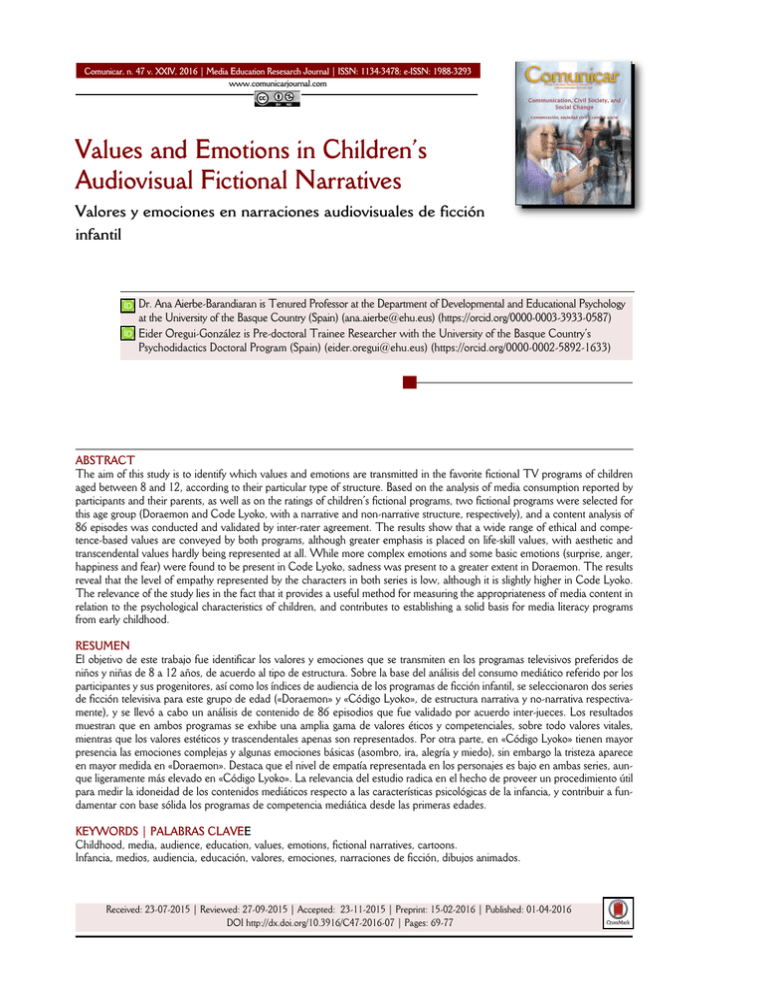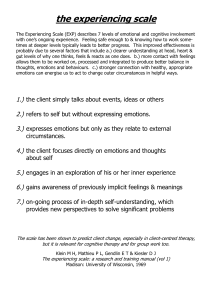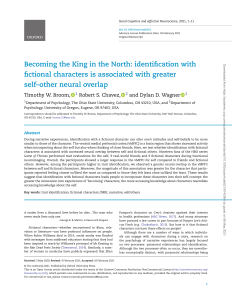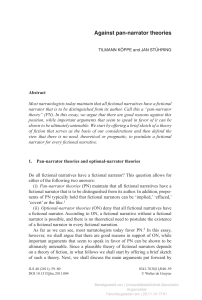Values and Emotions in Children`s Audiovisual Fictional Narratives
Anuncio

Comunicar, n. 47 v. XXIV, 2016 | Media Education Resesarch Journal | ISSN: 1134-3478; e-ISSN: 1988-3293 www.comunicarjournal.com Values and Emotions in Children’s Audiovisual Fictional Narratives Valores y emociones en narraciones audiovisuales de ficción infantil Dr. Ana Aierbe-Barandiaran is Tenured Professor at the Department of Developmental and Educational Psychology at the University of the Basque Country (Spain) ([email protected]) (https://orcid.org/0000-0003-3933-0587) Eider Oregui-González is Pre-doctoral Trainee Researcher with the University of the Basque Country’s Psychodidactics Doctoral Program (Spain) ([email protected]) (https://orcid.org/0000-0002-5892-1633) ABSTRACT The aim of this study is to identify which values and emotions are transmitted in the favorite fictional TV programs of children aged between 8 and 12, according to their particular type of structure. Based on the analysis of media consumption reported by participants and their parents, as well as on the ratings of children’s fictional programs, two fictional programs were selected for this age group (Doraemon and Code Lyoko, with a narrative and non-narrative structure, respectively), and a content analysis of 86 episodes was conducted and validated by inter-rater agreement. The results show that a wide range of ethical and competence-based values are conveyed by both programs, although greater emphasis is placed on life-skill values, with aesthetic and transcendental values hardly being represented at all. While more complex emotions and some basic emotions (surprise, anger, happiness and fear) were found to be present in Code Lyoko, sadness was present to a greater extent in Doraemon. The results reveal that the level of empathy represented by the characters in both series is low, although it is slightly higher in Code Lyoko. The relevance of the study lies in the fact that it provides a useful method for measuring the appropriateness of media content in relation to the psychological characteristics of children, and contributes to establishing a solid basis for media literacy programs from early childhood. RESUMEN El objetivo de este trabajo fue identificar los valores y emociones que se transmiten en los programas televisivos preferidos de niños y niñas de 8 a 12 años, de acuerdo al tipo de estructura. Sobre la base del análisis del consumo mediático referido por los participantes y sus progenitores, así como los índices de audiencia de los programas de ficción infantil, se seleccionaron dos series de ficción televisiva para este grupo de edad («Doraemon» y «Código Lyoko», de estructura narrativa y no-narrativa respectivamente), y se llevó a cabo un análisis de contenido de 86 episodios que fue validado por acuerdo inter-jueces. Los resultados muestran que en ambos programas se exhibe una amplia gama de valores éticos y competenciales, sobre todo valores vitales, mientras que los valores estéticos y trascendentales apenas son representados. Por otra parte, en «Código Lyoko» tienen mayor presencia las emociones complejas y algunas emociones básicas (asombro, ira, alegría y miedo), sin embargo la tristeza aparece en mayor medida en «Doraemon». Destaca que el nivel de empatía representada en los personajes es bajo en ambas series, aunque ligeramente más elevado en «Código Lyoko». La relevancia del estudio radica en el hecho de proveer un procedimiento útil para medir la idoneidad de los contenidos mediáticos respecto a las características psicológicas de la infancia, y contribuir a fundamentar con base sólida los programas de competencia mediática desde las primeras edades. KEYWORDS | PALABRAS CLAVEE Childhood, media, audience, education, values, emotions, fictional narratives, cartoons. Infancia, medios, audiencia, educación, valores, emociones, narraciones de ficción, dibujos animados. Received: 23-07-2015 | Reviewed: 27-09-2015 | Accepted: 23-11-2015 | Preprint: 15-02-2016 | Published: 01-04-2016 DOI http://dx.doi.org/10.3916/C47-2016-07 | Pages: 69-77 Comunicar, 47, XXIV, 2016 70 1. Introduction and current context The period between the ages of 8 and 12 is defined by a series of specific characteristics in relation to children’s cognitive, affective and social-moral development. It is a period during which youngsters open up (both cognitively and socially) to the world around them. As they develop their ability to think, so too do they become increasingly capable of perceiving values. Empirical studies on emotions in general, and on the empathic response in particular, have found that from age 8 onwards, children are capable of distinguishing almost all the emotions that an adult is able to discern (Boone & Cunningham, 1998). Fictional television shows, particularly cartoons, constitute one of many teaching-learning opportunities in which, through their favorite characters, children gain greater knowledge of concepts, procedures, attitudes, rules, values and emotions, although the regulating influence of teachers and parents is vital in this sense (Rajadell, Pujol, & Violant, 2005). In general, studies on children’s media diet indicate that the shows watched by the youngest members of the population are almost exclusively fictional programmes (cartoons, series and films), with cartoons being the most popular (Fuenzalida, 2005; Tur & Grande, 2009). On average, during the week children watch between 1 and 2 hours of television a day, with this time increasing to between 3 and 4 hours at the weekend. They watch content on different openaccess thematic channels (for example, Clan TVE, Disney Channel), although they also view programs targeted specifically at young people and adults (Cánovas & Sahuquillo, 2010). The websites of these channels offer no code systems to help parents decide whether or not certain cartoon series are suitable to their children’s development level (Bermejo, 2011; Torrecillas-Lacave, 2013). In relation to the Internet, much like with television, use at weekends is almost as much as it is during the week (Sánchez & Muñoz, 2009). When using computers, girls are more active than boys and also tend to connect to the Internet more (AIMC, 2014). The aim of computer use is also different (Bringué & Sádaba, 2011).There can be no doubt that today, the Internet is the single most popular medium among children and adolescents for information access, leisure and communication. Nevertheless, it is difficult to calculate exactly how much time children spend on the web, since increasingly they tend to access it from a wide range of different devices, many of which are both small and portable (Garmendia, Garitaonandia, Martínez, & Casado, 2011). Indeed, the current trend is towards multi-screen media usage, characterized by a change from the television set to the computer in order to view TV content over the Internet. Moreover, a number of different series are broadcast and viewed on tablets or mobile telephones. There is also a growing trend among children and adolescents to access video games on line, in order to play with their friends and/or with strangers. This has both its advantages and its risks (Chicharro, 2014), and is a trend that is spreading fast, particularly among boys who access these games using their mobile telephones (CIDE, 2004). Consequently, children today form part of the «mobile» generation, with mobile phones overtaking all other devices to become the «screen of screens» (Bond, 2013; Bringué & Sádaba, 2011). Children’s current media diet, which is increasingly beyond parental control (Gabelas & Lazo, 2008) and whose level of information saturation may make it hard for children to understand the meaning of the messages conveyed, has prompted a number of studies into the emotions and values represented in fictional series targeted at children. This in turn has contributed to fostering the selection, production and dissemination of high-quality media products for younger viewers (Elzo, 2009). Some authors such as Rajadell, Pujol & Violant (2005) have analyzed the educational and cultural values conveyed by cartoon series, finding that certain positive values (such as goodness, responsibility and solidarity) and their respective counter-values, which have in the past been clearly manifest in children’s series, are no longer represented. Researchers have also analyzed the question of the identity and the values represented in children’s films. Ros (2007), for example, analyzed the film «Shrek», whose plot is based on a narrative structure similar to that of a classic fairytale, but which constantly includes twists designed to question the importance of appearances and certain «traditional» values represented by the characters. Other authors have drawn attention to the high level of violence present in children’s media content (MongShan-Yang, 2006; Tur & Grande, 2009), which, alongside antisocial values (such as selfishness or dishonesty), is often represented by the antagonist, while prosocial values (such as respect for others or cooperation) are generally embodied by the protagonist. One study conducted within the field of values during childhood, which was based on the theory postulated by Milton Rokeach (1973), is that by Donoso (1993) which, despite not using audiovisual material, nevertheless explored nine value categories elicited © ISSN: 1134-3478 • e-ISSN: 1988-3293 • Pages 69-77 from children aged between 8 and 12 as a result of narration. This approach enabled us to distinguish two their participation in value clarification activities types of narrative (Bermejo, 2005): one characterized carried out for that specific purpose. The author comby a vertical structure and a chronological time frame pared the experience-based values and value beliefs (setting, conflict and denouement), and another chamanifested by children in this age group, and then racterized by a horizontal structure and a disconticompared these values with those expounded by the nuous temporal order. children’s families and schools. The results revealed Several key studies in this field (Bermejo, 2005, that children scored high in life, affective and ethical Del-Río, Álvarez, & Del-Río, 2004; Del-Río & Del-Río, values, while the lowest scores were recorded for 2008) have attempted to show how some fictional aesthetic and transcendental values, as well as values children’s television series contribute to the construc«of being». We have used this same nine value catetion of vertical thinking with causal, motivational, spagory system in our research. tial and temporal narrative structures (e.g. The World In addition to values, another aspect to explore in relation to media content is the emotions represented, since It is worth underscoring the fact that, beyond merely emotions play a key role in determining children’s media considering the presence or absence of harmful contents usage (Soto & Vorderer, (e.g. violence or pornography), when assessing the age 2011). It is also generally accepted that emotions are appropriateness of fictional programs it is necessary to valued more highly in the context of media usage than in analyze their potential content in the realm of values and daily life (Bartsch, Vorderer, emotions, as well as their structure (narrative or nonMangold, & Viehoff, 2008). According to Sedeño narrative), since this impacts the development of different (2005), television language has a strong emotional charge, ways of thinking among children. something which both poses risks (e.g. becoming emotionally desensitized to violence between peers) and offers benefits (e.g. identifying of David the Gnome), while others (e.g. Dragon Ball) with characters that embody prosocial values). do the opposite, encouraging horizontal thinking, Whatever the case, television fiction «is a highly inwhich is inappropriate for school and is related to a fluential genre with a strong socializing capacity, since type of sensory, denarrativized thinking involving assoit conveys messages that often go unnoticed and which ciations based on mere proximity. Furthermore, in precede the conscious control of the audience, affecthese shows the normativity level (i.e. the degree to ting emotions, mobilizing viewers’ most intimate feewhich activities and habits common to normal human lings and fostering their emotional involvement with life are portrayed) is low, as is the presence of the stories being told» (Ferrés, 1996, p.104). Along empathy and emotions (Del-Río & Del-Río, 2008). In these same lines, Conde (1999) studied subjects’ resthe field of children’s advertising, Bringué (2012) ponses to frightening audiovisual sequences and conanalyzes content in order to explore different methods cluded that children aged between 5 and 8 are more of conveying the audiovisual message (formats). This frightened by scenes highlighting visual or perceptive author also uses reception analysis to explore the way aspects, regardless of the possibility (real or fictional) of commercial messages are interpreted by children, shothe events depicted actually taking place; adolescents, wing the different narrative options upon which said on the other hand, respond more intensely to realistic messages are based. sequences, with which they identify to a greater Bearing in mind that outlined above, the general degree. aim of this study was to analyze the media diet and In this study, we analyzed the internal structure of favorite fictional television programs of children in 3rd the audiovisual children’s story being told, in relation to and 6th grades of primary school, with the aim of the way in which events are distributed throughout the determining which values and emotions are conveyed, © ISSN: 1134-3478 • e-ISSN: 1988-3293 • Pages 69-77 Comunicar, 47, XXIV, 2016 71 Comunicar, 47, XXIV, 2016 72 and whether or not they are related to the type of structure upon which said programs are based. The specific aims were as follows: 1) To explore the media diet (television, computer, Internet, video games, tablet and mobile telephone) of the children aged between 8 and 12 who participated in this study: time spent on the various devices and preferred fictional content (cartoons, series, films). 2) To identify which values are most commonly represented in 8-10-year-old children’s favorite cartoon series, in accordance with their structure. 3) To determine which emotions are most commonly represented in 8-10-year-old children’s favorite cartoon series, in accordance with their structure. The results presented here form part of a broader, quasi-experimental research project that aims to explore the relationships established between media diet, attention levels and social-personal development during childhood. 2. Method 2.1. Sample Group Participants were children aged between 8 and 12 (M=10.04) in 3rd and 6th grades of different primary schools located in the Autonomous Region of the Basque Country (Spain). Of the children in the sample group, 92 were boys (49.5%) and 94 were girls (50.5%). The sample was therefore evenly distributed in relation to sex. 39.2% (N=73) of the children in the sample group were in 3rd grade, while 60.8% (N= 113) were in 6th grade. The sample group was drawn from two public schools (44.08%, N=82) and two semi-private schools (i.e. private schools with some state funding) (55.92%, N=104). 153 parents also participated in the study. Of these, we know that 31 were fathers and 121 were mothers, although in the remaining case, no information was provided regarding which parent completed the questionnaire. Of the total number of questionnaires sent out (N=186), no response was received for 33. The corpus on which the content analysis was based comprised 86 episodes of two children’s cartoon series, «Doraemon» and «Code Lyoko». The sampling method used was intentional, both as regards episodes and viewing habits. In the first case, the overall corpus was divided into seasons, and then episodes were selected at random from different seasons. Children and their parents were also selected through intentional sampling, bearing in mind the type of school (public/semi-private), grade and sex. 2.2. Measurement instruments An observation template was created ad hoc to analyze the content of episodes from the two cartoon series selected and the resulting values were classified into nine categories in accordance with Donoso’s (1992) adapted version of Rokeach’s value system (1973): 1) Life; 2) Production; 3) Ethical; 4) Social; 5) Affective; 6) Non-ethical or intellectual; 7) Aesthetic; 8) Transcendental; and 9) «of Being». For their part, emotions are grouped in accordance with Aritzeta, Pizarro, & Soroa (2008) into: Basic emotions (e.g. happiness, sadness) and Complex emotions (e.g. boredom, confusion), with this latter group including Moral emotions (e.g. empathy, indignation) also. The details of children’s media diet were recorded using the «Children’s Media Diet Questionnaire» (CMI) (Aierbe & Oregi 2014), which was completed by parents in an estimated time of 30 minutes. The questionnaire comprises 26 items related to different indicators, such as: children’s media viewing habits, the physical and social context in which screens are used and parental mediation. The following items were taken into account for the purposes of this study: time spent using screens on weekdays and at weekends (items 1 and 2); most-viewed type of fictional program (item 9); child’s favorite fictional program (item 11). Furthermore, children’s preferences regarding fictional programs were recorded in a semi-structured individual interview lasting between 20 and 30 minutes. The interview comprised 24 questions aimed at exploring the values and emotions perceived by children in the characters of the episode viewed (during the experimental phase of the broader study) and eliciting information about their favorite shows. 2.3. Procedure Firstly, audience shares from January to November 2013 were requested from the agency Kantar Media. Secondly, we contacted the schools and parents were informed and asked to complete the CMI questionnaire. After obtaining parents’ informed consent, individual interviews were held with students. The selection criteria for the two cartoon series included, in addition to high audience shares and preference levels, the fact that they had different structures (narrative and non-narrative). As a result, the final selection consisted of Doraemon (broadcast by Boing and the regional television channel ETB3) and Code Lyoko (broadcast by Clan and ETB3). The first series is about a cosmic robot cat who travels back in time to our era from the 22nd century to help his friend © ISSN: 1134-3478 • e-ISSN: 1988-3293 • Pages 69-77 Nobita sort out all his everyday problems with his parents and friends. He generally does this by taking various gadgets out of his magic pocket. The second is a French cartoon series that recounts the adventures of a group of friends who discover a virtual world called «Lyoko» (https://goo.gl/3zKM88) and become embroiled in a struggle against a computer virus called X.A.N.A. which is plotting to destroy the world in which they live. In order to determine whether the audiovisual story is based on a narrative or non-narrative framework, a structural analysis was carried out of each series, using the work of Del-Río, Álvarez and Del-Río (2004) and Bermejo (2005) as references. Next, the content of the different episodes from each series was analyzed, using an observation template created ad hoc. The values and emotions represented in each episode were categorized by researchers by means of inter-rater agreement. 43 episodes were viewed and categorized for each series, making the total number of episodes analyzed 86. The inter-rater agreement level obtained had a Kappa index of .80. The data were first grouped into the categories established a priori for qualitative analysis, and were subsequently analyzed using the S P S S Statistics program (22.0). T h e structural analysis of each series was conducted in accordance with the works of Del Río, Álvarez & del Río (2004) and Bermejo (2005). It revealed that «Dorae mon» has a narrative structure that conforms to the classi© ISSN: 1134-3478 • e-ISSN: 1988-3293 • Pages 69-77 Comunicar, 47, XXIV, 2016 73 Figure 1. Media diet during the week and weekend. cal narrative structure found in children’s stories (setting, conflict, denouement), while «Code Lyoko» has a non-narrative structure in which both the temporal and spatial orders are disrupted (virtual/real environment). Finally, the content of the different episodes from each series was analyzed, using an observation template created independently by the two researchers. The qualitative analysis was based on the a priori categories, and the emotions and values observed in the programs were categorized through inter-rater agreement (Kappa index). The quantitative analysis Comunicar, 47, XXIV, 2016 74 was conducted through univariate (frequencies, mean and standard deviation) and bivariate analyses, such as means comparisons (Student t and MannWhitney tests). The statistical processing of the data was carried out using the SPSS 22 Statistics program. 3. Results 3.1. Media diet According to the children’s parents, as shown in Figure 1, during the week the participants in our study spend most of their screen time watching television followed by computers. At the weekend, screen time increases by about an hour each day and, although television remains the device in front of which most time is spent, participants spend more time playing video games than on the computer. Tablets are the least-used devices, both during the week and at weekends. As regards age differences, during the week, children aged 11 and 12 spend more time on the Internet (Z=-2.176; p<.05; mean 1.05 vs .40) and on their phones (Z=-2.037; p<.05; mean .75 vs .38) than those aged 8 and 9. Differences were also found in relation to sex, with boys spending more time than girls playing video games, both on weekdays (Z=-2.596; p<.01; mean 1.10 vs .24) and at weekends (Z=-2.787; p<.01; mean 1.85 vs .47. In relation to favorite fictional contents, the data provided by the children (see Table 1) coincide with both those reported by parents and audience shares. According to parents, the fictional programs their children watch most are cartoons (M=3.71; SD=.995) and series (M=3.63; SD=.829), with films (M=2.80; SD=.853) and other types of program (M=2.68; SD=1.071) being less popular. Favorite shows include «Jessie» (18.9%), «La que se avecina» (9.4%), «The Simpsons» (7.5%), «Pokemon» (7.5%), «Good Luck Charlie» (5.7%), «Violetta» (5.7%), «Doraemon» (3.8%), «iCarly» (3.8%), «Phineas & Ferb» (3.8%), «Adventure Time» (3.8%), and/or «Shake it up» (3.8%). The results show that, in addition to cartoons, participants also watch shows aimed at adults, such as «La que se avecina», «The Simpsons» and, to a lesser extent, «Aída». Girls have a greater preference for series (Z=-2.117; p<.05; mean 3.90 vs 3.35) than boys do, and although they did not spontaneously mention «Code Lyoko» as one of their favorites, most admitted to being familiar with it or having watched it in the past. 3.2. Content analysis in relation to values and emotions The presence of values and emotions was explored in both series in order to identify similarities and differences in accordance with structure. To this end, the two researchers independently coded each episode. The level of convergence between the scores awarded in the separate assessments was very high (Cohen’s kappa index =.70). An overall reading of the results obtained reveals a greater presence of values in all categories in Code Lyoko (LY) than in Doraemon (DO) (table 2), with the exception of aesthetic and transcendental values. Also, the subcategories of represented values were identified more frequently in LY than in DO. Table 3 shows the ones with the greatest presence. The content analysis regarding emotions revealed that all types of general emotions, both basic and complex, are more frequently represented in LY (see table 4 en https://goo.gl/33JBEs). In relation to the emotion subcategories, as shown © ISSN: 1134-3478 • e-ISSN: 1988-3293 • Pages 69-77 in table 5, with the exception of sadness, all basic and complex emotions are represented more frequently in LY. Moreover, within the set of complex emotions, the moral emotions Empathy and Indignation are particularly well represented. Given that LY episodes last approximately twice as long as DO ones (22 min vs 12 min, on average), the scores were weighted to compensate for the time bias. Thus, the values and emotions represented were calculated per minute for each series, and the results revealed that all the initial differences in favor of LY remained unchanged, with the exception of ethical values, whose scores for both programs were evened out as a result of the weighting. 4. Discussion and conclusions In general, as regards the primary aim of this study, it was found that children tend to spend more time in front of screens at the weekend than during the week, and TV viewing time, in particular, increases twofold. There is an increased tendency to use the Internet to view television programs (either re-watching episodes or catching up on those that were missed), especially among girls, which suggests that, although Internet use is on the rise and is accessed through a wide range of different screens, television still remains the most popular media format among children (Cánovas & Sahuquillo, 2010). The results reveal that children are starting to use mobile phones at an increasingly early age, and use is also increasing among 6th graders (Bond, 2013; Garmendia & al., 2011), while video games were found to be more popular with the boys in our study than with the girls (Bringué & Sádaba, 2011; Chicharro, 2014). Furthermore, participants’ favorite programs are cartoons and series, findings which confirm the results © ISSN: 1134-3478 • e-ISSN: 1988-3293 • Pages 69-77 reported by some previous studies (Fuenzalida, 2005; Tur & Grande, 2009), although they differ from those obtained by Bringué & Sádaba (2011), who found films to be more popular than series and cartoons. However, we did observe a growing trend, especially among girls, towards watching series that deal with issues and themes more appropriate for teenagers (amorous relations, etc.) at an increasingly early age (8-9 years old). Hence, one of the most popular TV channels was Disney Channel. Boys prefer cartoons, especially those which focus on fighting/action or sport. These programs are mainly broadcast on Boing. For their part, participants aged 11-12 also tend to watch both animated and non-animated series targeted at adults (Cánovas & Sahuquillo, 2010). To conclude, not only are age ranges becoming increasingly blurred as regards the use of different screen devices and preferred contents, gender differences are also observed in both media use and favorite fictional programs (Bringué, 2012; Garmendia & al., 2011). Both these findings merit further research. As regards our second aim, the analysis of values in relation to the structure of fictional contents revealed interesting results. We found that a wide range of ethical and competence-related values (particularly life values) were represented in both series, while aesthetic and transcendental values were hardly represented at all. It was, however, in Code Lyoko (LY, non-narrative structure) that competence-related values were identified most frequently, more so than in Doraemon (DO, narrative structure), although ethical values were found to be present to a similar extent in both series. These results contradict those found by Rajadell et al. (2005), but coincide with those obtained by Tur & Grande (2009) and Donoso (1993), which seems to indicate that, regardless of the time elapsed and the recourses used, the values represented correspond to the developmental stage we are focusing on here. In relation to the third aim of this study, the identification of emotions in accordance with structure, basic emotions were found to be present in both series to a similar extent, although complex emotions were more frequently identified in LY. The level of empathy represented was low in both series, although it was slightly higher in LY. Comunicar, 47, XXIV, 2016 75 Comunicar, 47, XXIV, 2016 76 The lesser degree to which values and complex emotions are represented in DO may be due to the fact that each episode focuses on just a few values and emotions in comparison with LY. This enables the series to work with formal resources that make it easier for younger children (aged between 8 and 9) to perceive them. For example, the contrast between happiness and sadness that can be found in DO is greater than in LY, since fewer emotions are represented. However, the structural characteristics (non narrative) and content (greater number and variety of values represented, as well as complex emotions) of LY may prevent younger children from fully understanding the messages conveyed and discerning the consequences and motivations underlying the characters’ thoughts, emotions and actions. If we combine this with other characteristics, such as the scarce representation of empathy and the low level of normativity regarding the real-life activities and habits depicted, we can infer that LY is not ideal viewing content for this age range (Bermejo, 2005, 2011; Del-Río & Del-Río, 2008). Curiously enough, this series is more popular among 3rd grade students than among 6th graders, mainly boys in both cases, since students aged between 11 and 12 mainly report no longer viewing LY and DO. It is worth underscoring the fact that, beyond merely considering the presence or absence of harmful contents (e.g. violence or pornography), when assessing the age appropriateness of fictional programs it is necessary to analyze their potential content in the realm of values and emotions, as well as their structure (narrative or non-narrative), since this impacts the development of different ways of thinking among children (Bermejo, 2005; Del-Río & Del-Río, 2008; Prensky, 2001). One thing to bear in mind is that, although the weighting of the results and the high level of inter-rater agreement attest to the good reliability of the data obtained, future research should seek to corroborate them in a broader sample, with different cartoon series. This analysis of content and structure is currently being complemented by the study of how the values and emotions perceived by children when watching these programs are received. The aim is to actively foster the development and selection of media content that is appropriate to the psychological needs of younger viewers, as well as to contribute to laying a solid foundation for media literacy programs from a very early age. Acknowledgments Study conducted by the University of the Basque Country within the project: EHU 13/65: «Children’s media diet, attention levels and perceived values» and the project UFI 11/04: «Psychology and Society in the 21st Century». Moreover, the authors have signed a Pre-doctoral Contract (PhD Training 2015, BES-2015.071923) within the Spanish Training Sub-program (Spanish Program for Promoting Talent and Employability in R&D&I), as part of the Spanish Plan for Scientific and Technical Research and Innovation 2013-2016, established by the Secretary of State for Research, Development and Innovation at the Spanish Ministry of the Economy and Competitiveness, co-funded by the European Social Fund. References Aierbe, A., Oregui, E., & Bartau, I. (2014). ¿Es posible fomentar la atención y el desarrollo socio-personal a través de las narraciones audiovisuales de ficción infantil? Conference Proceedings CIMIE14 by AMIE. (http://goo.gl/0l16VP) (2014-10-22). AIMC (2012). EGM: Niños en Internet. (http://goo.gl/sGHBMb) (2015-01-02). Aritzeta, A., Pizarro, M., & Soroa, G. (2008). Emociones y educación. Donostia: Erein. Bartsch, A., Vorderer, P., Mangold, R., & Viehoff, R. (2008). Appraisal of Emotions in Media Use: Toward a Process Model of Meta-Emotion and Emotion Regulation. Media Psychology, 11(1), 7-27. doi: http://dx.doi.org/10.1080/15213260701813447 Bermejo, J. (2005). Narrativa audiovisual: investigación y aplicaciones. Madrid: Pirámide. Bermejo, J. (2011). Consumo de los contenidos para la infancia en el nuevo escenario de la TDT. Telos, 87, 1-13. (https://goo.gl/8RMWcv) (2013-09-25). Bond, E. (2013). Mobile Phones, Risk and Responsibility. Understanding Children’s Perceptions. Cyberpsychology: Journal of Psychosocial Research on Cyberspace, 7(1). doi: http://dx.doi.org/10.5817/CP2013-1-3 Boone, R.T., & Cunningham, J.G. (1998). Children’s Decoding of Emotion in Expressive Body Movement: the Development of Cue Attunement. Developmental Psychology, 34(5), 1.007-1.016. doi: http://dx.doi.org/10.1037/0012-1649.34.5.1007 Bringué, X. (2012). Publicidad infantil y estrategia persuasiva: un análisis de contenido. Zer, 6(10). (http://goo.gl/bkhKCt) (2015-1123). Bringué, X., & Sádaba, C. (2011). La generación interactiva en España: Niños y adolescentes ante las pantallas. Madrid: Foro Generaciones Interactivas y Fundación Telefónica. (http://goo.gl/3meACo) (2015-11-23). Cánovas, P., & Sahuquillo, P.M. (2010). Educación familiar y mediación televisiva. Teoría de la Educación, 22(1), 117-140. (http://goo.gl/YwFaiE) (2012-09-30). CIDE/Instituto de la Mujer (2004). La diferencia sexual en el análisis de videojuegos. Madrid: Pardedós. Conde, E. (1999). La experiencia de ver televisión: respuesta emocional a secuencias audiovisuales de miedo (Tesis Doctoral). Tenerife: Universidad de la Laguna. Chicharro, M. (2014). Jóvenes, ficción televisiva y videojuegos: espectáculo, tensión y entretenimiento. Tendencias generales de consumo. Revista de Estudios de Juventud, 106, 77-91. Del-Río, P., & Del-Río, M. (2008). La construcción de la realidad por la infancia a través de su dieta televisiva. [Reality Construction by Spanish Infancy across TV Consumption]. Comunicar, 31(16), 99-108. DOI: http://dx.doi.org/10.3916/c31-2008-01-012 Del-Río, P., Álvarez, A., & Del-Río, M. (2004). Pigmalión: Informe sobre el impacto de la televisión en la infancia. Madrid: Fundación Infancia y Aprendizaje. Donoso, T. (1992). Análisis de valores en niños de 8 a 10 años. © ISSN: 1134-3478 • e-ISSN: 1988-3293 • Pages 69-77 Barcelona: Universidad de Barcelona. (http://goo.gl/s07RzS) (201311-19). Elzo, J. (2009). La transmisión de valores a menores. Informe extraordinario de la Institución del Ararteko al Parlamento Vasco. (http://goo.gl/rkuGn2) (2014-02-17). Ferrés, J. (1996). Televisión subliminal: Socialización mediante comunicaciones inadvertidas. Barcelona: Paidós. Fuenzalida, V. (2005). Expectativas educativas de las audiencias televisivas. Bogotá: Norma. Gabelas, J.A., & Lazo, C.M, (2008). Modos de intervención de los padres en el conflicto que supone el consumo de pantallas. Revista Latina de Comunicación Social, 63, 238-252. Garmendia, M., Garitaonandia, C., Martínez, G., & Casado, M.A. (2011). Riesgos y seguridad en Internet: Los menores españoles en el contexto europeo. Bilbao: Universidad del País Vasco, EU-Kids Online. (http://goo.gl/RnDbmp) (2015-10-20). Mong-Shan-Yang, M.A. (2006). Understanding the Effectiveness of Moral Mediation through Theories of Moral Reasoning. Ohio: The Ohio State University. (https://goo.gl/WhZwaa) (2013-08-26). Prensky, M. (2001). Digital Natives, Digital Inmigrants. On the Horizon, 9(5), 1-6. doi: http://dx.doi.org/10.1108/10748120110424816 Rajadell, N., Pujol, M.A., & Violant, V. (2005). Los dibujos animados como recurso de transmisión de valores educativos y culturales. © ISSN: 1134-3478 • e-ISSN: 1988-3293 • Pages 69-77 Comunicar, 25. (http://goo.gl/tb3Uqa) (2013-09-24). Rokeach, M. (1973). The Nature of Human Values. New York: Free Press. Rokeach, M. (1979). Understanding Human Values: Individual and Societal. New York: Free Press. Ros, N. (2007). El film ‘Shrek’: una posibilidad desde la educación artística para trabajar en la formación docente la lectura de la identidad y los valores. Revista Iberoamericana de Educación, 44(6), 112. Sarabia, F.J., & Muñoz, J. (2009). Actitud y mediación de la familia hacia la exposición a Internet de los niños y adolescentes: Un enfoque de marketing. ESIC Market, 133(9), 161-189. Sedeño, A.M. (2005). Emoción y hábitos de los niños frente a la televisión. Comunicar, 25(2). Soto, M.T., & Vorderer, P. (2011). About Entertainment= Emotion. Journal of Media Psychology, 23(1), 1-5. doi: http://dx.doi.org/10.1027/1864-1105/a000035 Torrecillas-Lacave, T. (2013). Los padres ante el consumo televisivo de los hijos: Estilos de mediación. Revista Latina de Comunicación Social, 68, 27-54. doi: http://dx.doi.org/10.4185/RLCS-2013968 Tur, V., & Grande, I. (2009). Violencia y prosocialidad en los contenidos televisivos infantiles visionados por menores en Alicante. Zer, 14(27), 33-59. (http://goo.gl/6qzA2B) (2012-11-07). Comunicar, 47, XXIV, 2016 77






